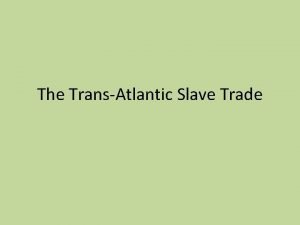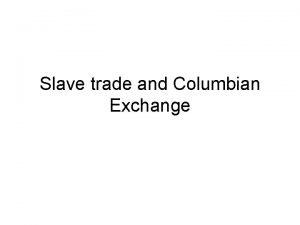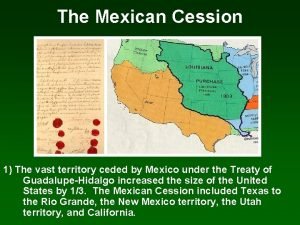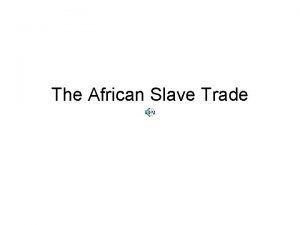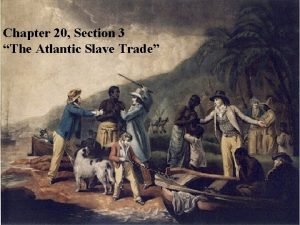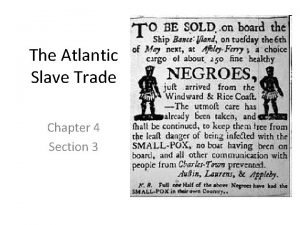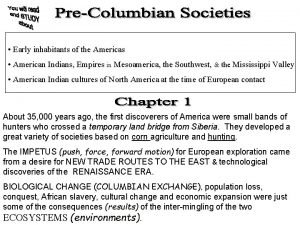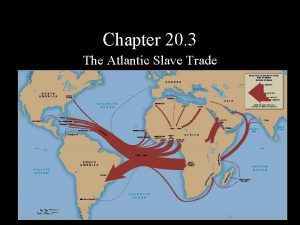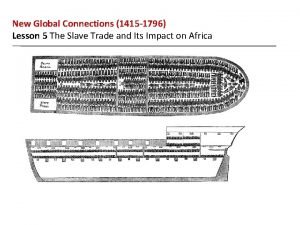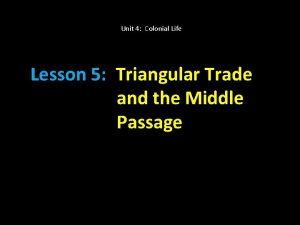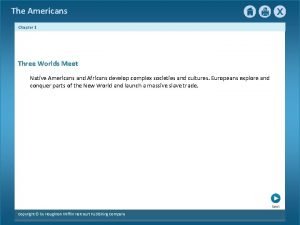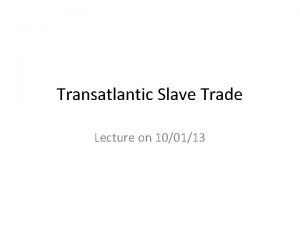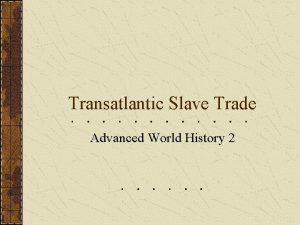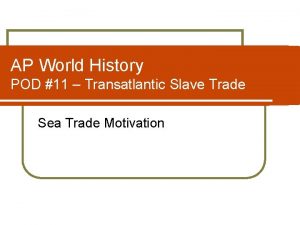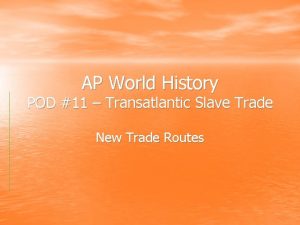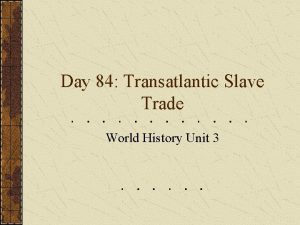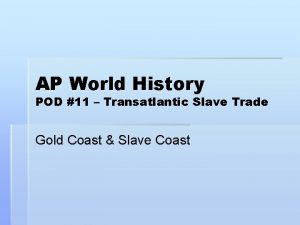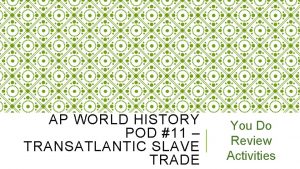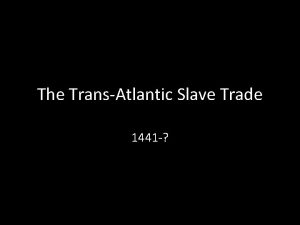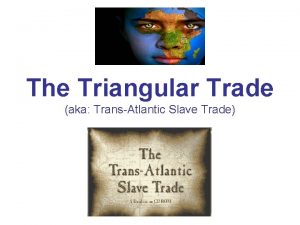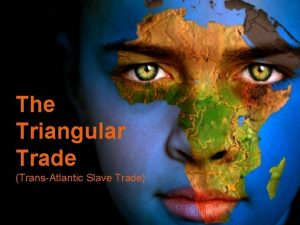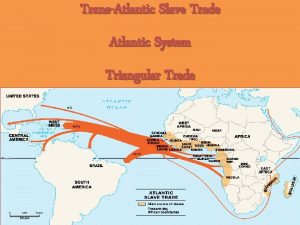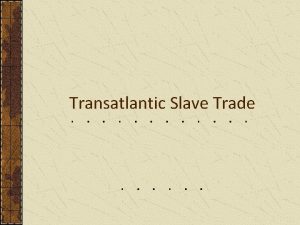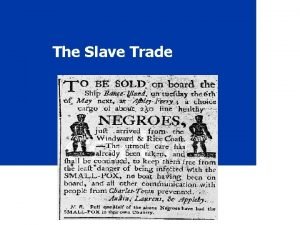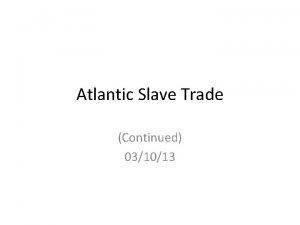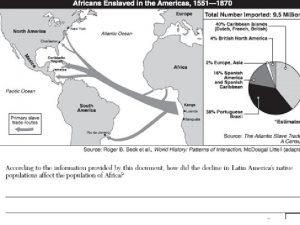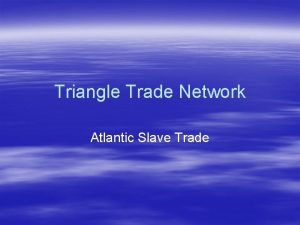Transatlantic Slave Trade Advanced World History 2 Old



















- Slides: 19

Transatlantic Slave Trade Advanced World History 2

Old World vs. New World Slavery Classical world and medieval slavery was not based on racial distinctions. Ancient world did not necessarily view slavery as a permanent condition. Slaves did not necessarily hold the loest status in early civilizations. Slaves in the old world often were symbols of prestige, luxury and power (true even in the ne world prior to European Colonization).

How was slavery justified? Early civilizations - accident or bad luck. Aristotle - notion of the “natural slave” Christian world - ‘Curse of Ham” 18 th Century European - pseudo-scientific racism.

Why was Africa vulnerable to the Slave Trade? Political Fragmentation Sailing Routes Availability of People (high birth rate) Civilizations and Skills (metalworking, farming, herding) No diplomatic repercussions.

Why not others? Disease Knowledge of terrain Different Agricultural Skills Supply deficit ( too many native American Deaths)

Countries Participating Britain Denmark France Holland Portugal Spain Norway

Why did European powers eventually turn to African labor? Labor supply was insufficient. Epidemics reduced the native population by 50% - 90%. Evidence of deeply help racist sentiment. Racism was a consequence of racial slavery as well as a cause. In English colonies the supply of servants decreased.

Geography of Slavery Enslaved Africans mostly came from the area stretching from the Senegal River in Africa to Angola. Europeans divided the area into five regions: Upper Guinea Coast Ivory Coast Lower Guinea Coast Gabon Angola

Why Africa? Sailing Routes Lack of Familiarity with the Americas Availability of People Civilizations and Skills Metal Working Farming Hearding No diplomatic repercussions

Two main patterns of Triangular Trade Rum from New England to West Africa Slaves to sugar islands Molasses home to the New England distilleries Manufactured goods from England to Africa Goods exchanged for slaves taken to West Indies. Profits used to purchase sugar (and other goods) for England.


Middle Passage Origins of the Infamous Middle Passage The middle leg of a three part voyage. Began and ended in Europe. Carried cargo of iron, cloth, brandy, firearms, gunpowder Landed on Africa’s Slave Coast and exchanged cargo for Africans Set sail for the Americas, where slaves were exchanged for sugar, tobacco, mlasses. Final brought the ship back to Europe.

Middle Passage 1600 - 1850’s The Capture Approx. 60 forts build along the west coast of Africa. Walked in slave caravans to the forts some 1000 miles away. Selected by the Europeans and branded. One half survived the death march. Place in underground dungeons until they were boarded on ships.

Middle Passage Statistics 15 -20 million Africans forcibly transported across the Atlantic from 1500 -1900. 10 -20% died during the Middle Passage Another 15 -30% dies during the march to the coast. For every 100 slaves that reached the New World, another 40 died in Africa or during the Middle Passage.

Middle Passage Conditions on Board the Ship Slaves chained together and crammed into spaces sometimes less than five feet high. Slavers packed three of four hundred Africans into the ship cargo holds. Little ventilation, human waste, horrific odors. Unclean.

British Slave Ship

Middle Passage Tight packing - belly to back, chained in twos, wrist to ankle (660+), naked. Loose packing - shoulder to shoulder chained wrist to wrist or ankle to ankle. Men and woman separated (men placed towards bow, women toward stern). Fed once or twice a day and brought on deck for limited times.

Middle Passage Journey lasted 6 -8 weeks. Due to high mortality rate, cargo was insured (reimbursed for drowning accidents but not for deaths from disease of sickness) Common to dump your cargo for sickness or food shortages. Slave mutinies on board ships were common (1 out of every 10 voyages across the Atlantic experience a revolt). Covert resistance (attempted suicide, jumped overboard, refusal to eat).

Olaudah Equiano African who was taken from his home tribe with his brother. Went through the middle passage. Bought freedom from working ships as a slave. Wrote narratives about the conditions of the middle passage.
 What is triangle trade
What is triangle trade Transatlantic slave trade pictures
Transatlantic slave trade pictures Transatlantic slave trade apush
Transatlantic slave trade apush The transatlantic slave trade
The transatlantic slave trade The transatlantic question
The transatlantic question Transatlantic encounters in history of education download
Transatlantic encounters in history of education download Washington dc slave trade
Washington dc slave trade Atlantic slave trade
Atlantic slave trade Chapter 20 section 3 the atlantic slave trade answer key
Chapter 20 section 3 the atlantic slave trade answer key Chapter 4 section 3 the atlantic slave trade
Chapter 4 section 3 the atlantic slave trade Effects of the slave trade on africa
Effects of the slave trade on africa The atlantic slave trade chapter 20 section 3
The atlantic slave trade chapter 20 section 3 Lesson 5 the slave trade and its impact on africa
Lesson 5 the slave trade and its impact on africa Slave trade primary sources
Slave trade primary sources Slave trade triangle
Slave trade triangle The age of exploration outcome the atlantic slave trade
The age of exploration outcome the atlantic slave trade The age of exploration outcome the atlantic slave trade
The age of exploration outcome the atlantic slave trade Transatlantic tunnel
Transatlantic tunnel Transatlantic cable inventor
Transatlantic cable inventor Chapter 1 section 5 transatlantic encounters
Chapter 1 section 5 transatlantic encounters

